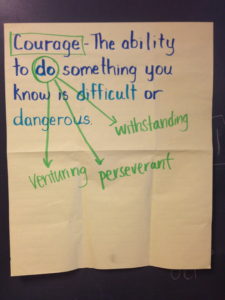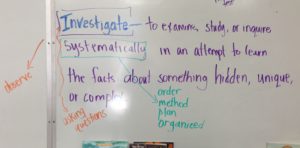It seems like many of the students I work with struggle to explain why or how a detail is supporting evidence for a main/central idea. Does this sound familiar?
What I have begun inquiring about in my practice is whether students have enough “language” to explain evidence. Maybe this is the missing piece. So for example, let’s say they did a close reading of an excerpt from Beyond Courage: The untold story of Jewish resistance during the Holocaust (Rappaport, 2012) for the following purpose – How did members of the Jewish resistance exhibit courage? Now if I asked a typical middle school student to tell me what “courage” means, they might say something like “brave” (a synonym) or they might give me an example of a time they were courageous. Would they say the following, though? Courage means the ability to do something that you know is difficult or dangerous. Would they add the following? Courage includes taking that first step, venturing into a difficult or dangerous act, persevering until your goal is met (which may take time), and withstanding harm to oneself in the process.
So what I have been trying to do is incorporate anchor charts with clear, but sophisticated definitions into close reading experiences. The anchor charts below are from recent lessons. Notice the language provided (in the definition of courage below) that students can access when they are explaining evidence – courage, doing something, difficult, dangerous, venturing, perseverant, withstanding. I was working with an 8th grade group during this lesson and they quickly began appropriating words like “difficult” and “dangerous” in their explanations of why certain acts of the Jewish resistance members (detailed in the text) exhibited courage. (I did not introduce the vocabulary words in green until the end of the lesson – I added them to the chart at that point – and would follow up in the next lesson by modeling their use in explaining evidence.)


In the image above, I was working with a group of fifth grade students reading texts about the work of scientists. At the beginning of the first lesson, when I asked them to tell me about what scientists do, many used the word “study”; I realized I needed to expand their language for describing the work of scientists. I introduced the term investigate with this definition. As we engaged in a close reading about one particular scientist, we added words to our definition (in orange and green). Again, with modeling and coaching, the students began to use these words in their explanations.
Seriously, I have fallen in love with crafting definitions for students. My joy is in how they fly with the language these definitions provide. However, I’m always observing and will make changes to definitions (on anchor charts) on the spot in front of the class as needed. For example, in one lesson, I used the word “obstacles” in a definition of the word “perseverant”; the sixth grade students were unsure of what obstacles meant, so I walked up to the anchor chart and added an arrow shooting from the word “obstacles” and wrote “problem that gets in the way.” For me, the anchor charts with definitions are living, breathing documents of our learning – I add, change, do whatever is necessary to make the language of the definition accessible – but still rigorous and helpful to students in explaining their thinking.
Okay. Just exploring scaffolding at the point of need and thought I’d share.
